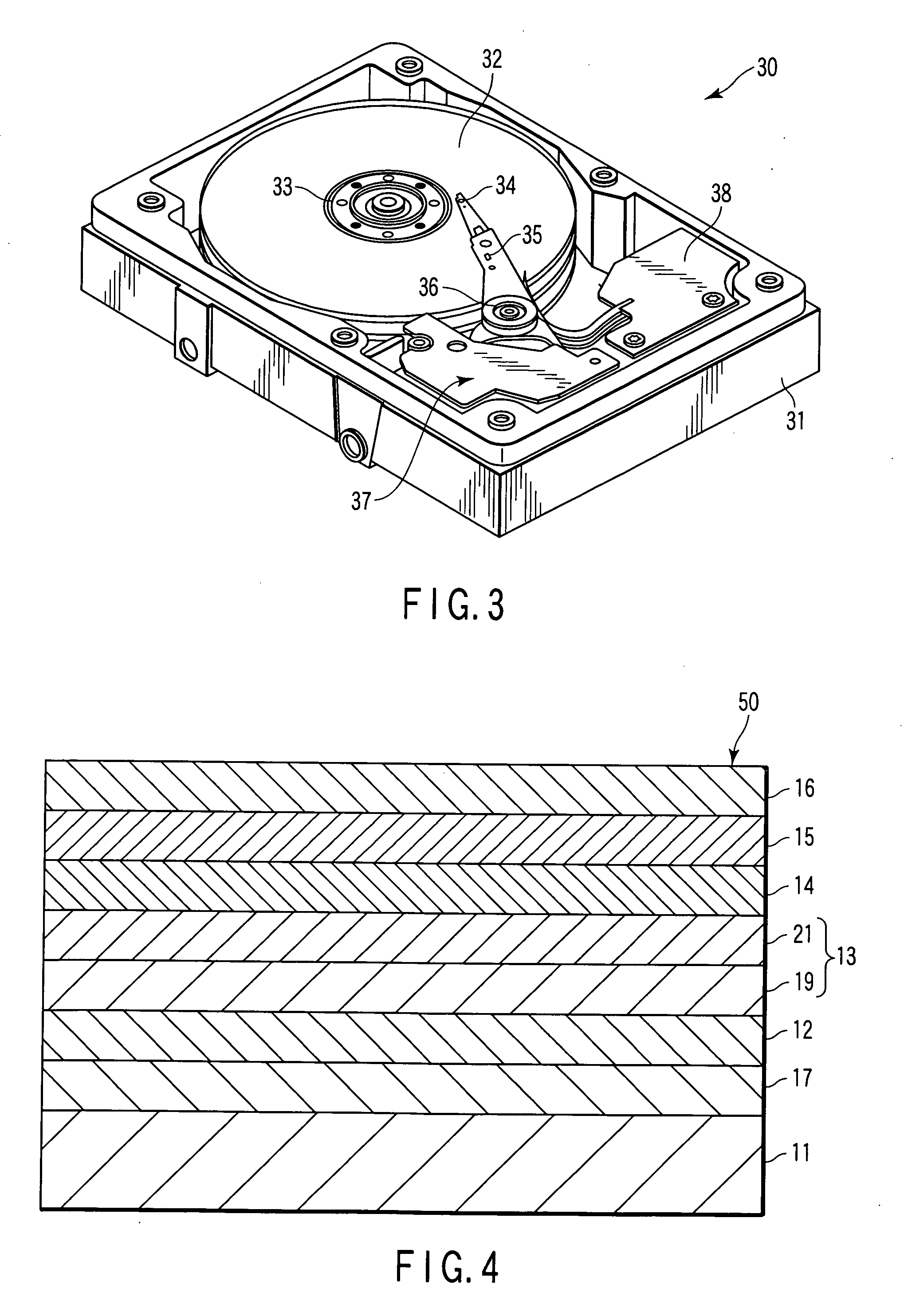Perpendicular magnetic recording medium and magnetic recording/reproduction apparatus
- Summary
- Abstract
- Description
- Claims
- Application Information
AI Technical Summary
Benefits of technology
Problems solved by technology
Method used
Image
Examples
example 1
[0061]A nonmagnetic substrate made of a glass substrate for a 2.5-inch magnetic disk was prepared.
[0062]This nonmagnetic substrate was placed in a vacuum chamber having a vacuum degree of 1×10−5 Pa, and DC magnetron sputtering was performed as follows in an Ar ambient at a gas pressure of 0.7 Pa.
[0063]First, the nonmagnetic substrate was set to oppose a target, and a 25-nm thick CoCrPt ferromagnetic layer was formed as a bias application layer by discharging DC 500 W to a CoCrPt target.
[0064]A 120-nm thick CoZrNb soft magnetic backing layer was formed on the obtained CoCrPt ferromagnetic layer.
[0065]After that, a 5-nm thick Si layer was formed as a nonmagnetic seed layer on the CoZrNb soft magnetic backing layer by discharging DC 500 W to an Si target in an Ar ambient at a gas pressure of 0.1 Pa lower than the normal pressure.
[0066]Then, a 5-nm thick Pd layer was formed as a first nonmagnetic underlayer on the Si seed layer by discharging. DC 500 W to a Pd target in an Ar ambient at...
example 2
[0133]As the first nonmagnetic underlayer of the medium of the present invention, two types of targets having different composition amounts, i.e., a Pd-34 at % Si target (the soft magnetic layer side) and a Pd-5 at % Si target (the perpendicular magnetic recording layer side) were prepared.
[0134]A perpendicular magnetic recording medium was manufactured following the same procedure as in Example 1 except that the above-mentioned two types of Pd—Si targets, i.e., the Pd-34 at % Si target and Pd-5 at % Si target were used instead of the Pd target as the first nonmagnetic underlayer and no Si seed layer was formed.
[0135]The obtained perpendicular magnetic recording medium had the same layer arrangement as that of the perpendicular magnetic recording medium shown in FIG. 2 except that no Si seed layer was formed and two Pd—Si layers having different compositions were formed as the first nonmagnetic underlayer.
[0136]FIG. 4 is a schematic sectional view showing the arrangement of the obta...
example 3
[0175]A perpendicular magnetic recording medium was manufactured following the same procedure as in Example 1 except that a nonmagnetic seed layer was formed using an Al-45 at % Si target instead of the Si target.
[0176]The obtained perpendicular magnetic recording medium had the same layer arrangement as that of the perpendicular magnetic recording medium shown in FIG. 2 except that the AlSi seed layer was formed instead of the Si seed layer.
[0177]X-ray diffraction measurement was performed on the medium of the present invention.
[0178]As a consequence, an Ru(00.2) peak and CoCrPt (00.2) peak were observed, but no Pd(111) peak was observed. When rocking curve measurement was performed on these peaks, the half-widths of the peaks were 2.70 (Ru) and 3.4° (CoCrPt). This shows that the perpendicular magnetic recording layer had good crystallinity.
[0179]The crystal structure of the medium of the present invention was checked by performing transmission analytical electron microscope (TEM) ...
PUM
 Login to View More
Login to View More Abstract
Description
Claims
Application Information
 Login to View More
Login to View More - R&D
- Intellectual Property
- Life Sciences
- Materials
- Tech Scout
- Unparalleled Data Quality
- Higher Quality Content
- 60% Fewer Hallucinations
Browse by: Latest US Patents, China's latest patents, Technical Efficacy Thesaurus, Application Domain, Technology Topic, Popular Technical Reports.
© 2025 PatSnap. All rights reserved.Legal|Privacy policy|Modern Slavery Act Transparency Statement|Sitemap|About US| Contact US: help@patsnap.com



